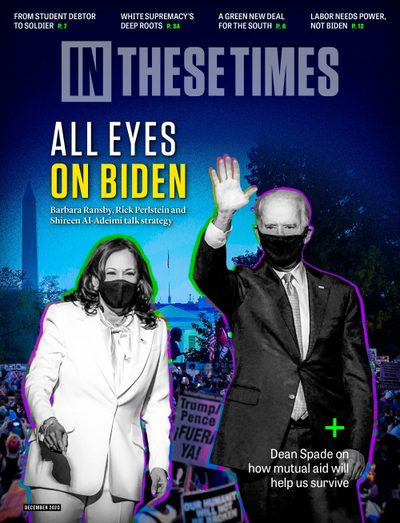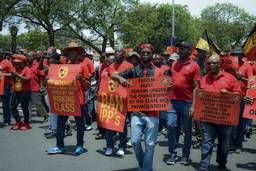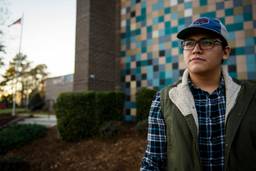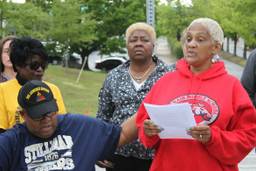Why the South Is Organizing Its Own Green New Deal
Amid devastating hurricanes, oil spills and refinery fires, the Gulf South pushes for a Green New Deal that will meet its needs.
Casey Williams

LAKE CHARLES, LA. — After Hurricane Laura hit in late August, a local chemical plant erupted in flames. The fire, one of 31 post-Laura oil and chemical leaks reported, sent up plumes of smoke and chlorine gas. Louisiana officials told residents (many of whom had lost power or their homes) to shelter in place and turn off their air conditioning in the summer heat to avoid the fumes.
“How do you shelter in place with no shelter?” KD Minor, a community organizer from Lake Charles, asked during a virtual conference in August. Minor began coordinating relief before Laura hit, providing residents with gas money to evacuate. Others matched her contributions, and “$5 turned into $1,000,” which Minor distributed through Forever Calcasieu, a mutual aid network. Minor is still helping people get assistance as hurricanes batter the region.
Laura wasn’t the first storm to expose overlapping vulnerabilities in the Gulf South — where thousands of oil and gas wells, refineries and petrochemical plants sit in a storm path supercharged by the emissions of the fossil fuel industry — nor will it be the last. While residents of Texas, Louisiana, Mississippi, Alabama and Florida are building mutual aid networks, they’re also making longer-term plans, like the Gulf South for a Green New Deal.
Like the national Green New Deal (GND) resolution, the Gulf South GND proposes slashing planet-warming emissions through an energy transition with well-paying union jobs, housing, transportation and healthcare for all. But the Gulf South platform goes further, calling for an end to pipeline construction, divestment from regional military installations and repurposing fossil fuel infrastructure for renewable energy. It also demands food sovereignty, reparations for Black, Brown and Indigenous people, and the redistribution of unpolluted lands to marginalized groups.
The platform “outlines what the Green New Deal would need to succeed in the South and, therefore, nationally,” says Emma Collin, director of programs for the not-for-profit Gulf Coast Center for Law & Policy (GCCLP), which coordinates the initiative. No climate plan can win material gains without leadership from “people who work in the energy industry, who have lived through climate disasters, and who have been on the front lines of a lot of America’s darkest histories,” she says.
Local farmworkers, fisherfolk, labor groups and Indigenous nations created the platform, meeting over six months in 2019 to decide what they liked about the national GND and what was missing from it. The result lays out a long-term vision that the platform’s more than 150 signatories, including Sunrise Movement, are organizing around.
The GCCLP submitted the platform to the House Select Committee on the Climate Crisis and other policy-making bodies, but signatories are planning state and regional campaigns. Nurses, teachers and other frontline workers — many non-union — have led much of the organizing, while industrial unions have been more reluctant.
“How do you sell the refinery hole watcher” on the Green New Deal, Minor asks. “They hear ‘change’ and what that really says to them is ‘cut.’”
But change is inevitable. With nearly 4,300 orphaned oil and gas wells in Louisiana (and more infrastructure to be abandoned as Covid-19 slashes oil revenues), the Green New Deal’s wager is that a planned, democratically managed transition will be better for working people than a chaotic, corporate retreat.
“I use that old union phrase, ‘If you’re not at the table, you’re on the menu,’ ” says Ryan Pollock, an electrician and organizer with IBEW 520 in Austin, Texas. In 2019, Pollock persuaded the Texas AFL-CIO to pass a Green New Deal-style resolution. While industrial workers are warming to GND proposals, he says, they need to get much more militant. “We’ve let ourselves be on the menu far too often.”
Climate disaster raises the stakes. After Hurricane Ivan struck a Louisiana drilling platform in 2004, oil poured into the Gulf for 16 years. Katrina spilled 8 million gallons of oil. When Harvey hit Texas in 2017, millions of gallons of chemicals entered waterways. In Port Arthur, Texas, refinery operators burned what was left in their pipes to prevent clogging, sending toxic gas over the city, according to local community organizer Hilton Kelley. Weeks later, a nearby Valero refinery caught fire.
“We have to get real about changing the dynamics around how we get energy,” Kelley says. “Because the old way is killing people.”
Gulf states supply 75% of the country’s liquid fuel and 125,000 miles of pipeline snake across Louisiana alone, but far fewer people work in fossil fuel than the industry claims. “It’s sort of this mythology … that the petrochemical industry is what makes Louisiana work,” says Darryl Malek-Wiley, an organizer with Sierra Club’s Environmental Justice and Community Partnerships Program. In reality, polluting industries have “taken most of the wealth and shipped it someplace else.”
In Lake Charles, people are “slowly but steadily” connecting the dots between extractive industry and climate disaster, Minor says. Collin hopes the Gulf South GND can make those connections clearer, adding that the GND branding is less important than what it hopes to do.
“The win,” Collin says, “is material change.”
Casey Williams is a researcher and freelance writer based in New Orleans. He writes about climate, energy and labor politics around the world. Williams has published work in The New York Times, The Nation, HuffPost, and other local and national outlets.








